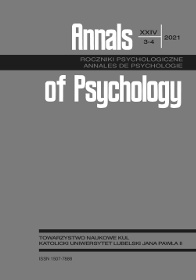On the Relationship Between Intuition, Consciousness and Cognition: In Search of a Unified Concept of Mind
Abstract
This paper argues that within contemporary neuroscience and cognitive psychology a new theoretical framework is emerging for the integrated consideration of unconscious (intuitive) processing with conscious ones. This framework requires inclusion of new theories of the brain and consciousness dynamics (Baars, Damasio, Dehaene, Friston, Gazzaniga, LeDoux), evolution of the human memory system (Tulving), and theories of procedural, associative and working memory (Baddley, Reber). Evolutionarily old intuitive processing is not unique, and it is an integral component of any cognitive processes. A revolutionary new synthesis combining intuitive and conscious processing may take the form of a mind vector integrating the two.
References
Baars, B. J. (1988). A cognitive theory of consciousness. Cambridge University Press.
Baddley, A. (2012). Working memory: Theories, models, and controversies. Annual Review of Psychology, 63, 1–29. https://doi.org/10.1146/annurev-psych-120710-100422
Bergson, H. (1913). Introduction to metaphysics. Liberal Arts Press.
Berlyne, D. E. (1963). Structure and direction in thinking. John Wiley.
Brunswik, E. (1955). “Ratiomorphic” models of perception and thinking. Acta Psychologica, 11,108–109. https://doi.org/10.1016/S0001-6918(55)80069-8
Chomsky, N. (2016). What kind of creatures are we? Columbia University Press.
Cloninger, C. R., Svrakic, D. M., & Przybeck, T. R. (1993). A psychobiological model of temperament and character. Archives of General Psychiatry, 50(12), 975–990. https://doi.org/10.1001/archpsyc.1993.01820240059008
Damasio, A. (1994). Decartes’ error: Emotion, reason, and the human brain. Penguin Books.
Damasio, A. (1999). The feeling of what happens: Body and emotion in the making of consciousness. Harcourt College Publishers.
Damasio, A. (2011). Self comes to brain: Constructing the conscious brain. Vintage Books.
Dehaene, S. (2014). Consciousness and the brain: Deciphering how the brain codes our thoughts. Viking.
Descartes, R. (2019). Rozprawa o metodzie [Discourse on the method] (T. Żeleński, Trans.). Wydawnictwo Vis-á-vis Etiuda.
Descartes, R. (2002). Reguły kierowania umysłem. Poszukiwanie prawdy poprzez światło umysłu [Rules for the direction of the mind. Seeking truth by the light of the mind]. Wydawnictwo Antyk.
Friston, K. (2010). The free-energy principle: A unified brain theory? Nature Reviews Neuroscience, 11, 127–138. https://doi.org/10.1038/nrn2787
Friston, K. J., Wiese, W., & Hobson, J. A. (2020). Sentience and the origins of consciousness: From Cartesian duality to Markovian monism. Entropy, 22(5), 516. https://doi.org/10.3390/e22050516
Gazzaniga, M. (2019). The consciousness instinct. Farrar Straus & Giroux.
Godfrey-Smith, P. (2018). Other minds: The octopus, the sea and the deep origins of consciousness. Farrar Straus & Giroux.
Helmholtz, H. von (1977). Epistemological writings. Reidel Publishing Company.
Husserl, E. (1900). Logische Untersuchungen. Niemeyer.
Jajnes, J. (1976). The origin of consciousness in the breakdown of the bicameral mind. Mariner Books.
Janeczek, S. (2003). Logika czy epistemologia [Logics or epistemology]. Wydawnictwo KUL.
Jung, C. G. (1997). Typy psychologiczne [Psychological types] (R. Reszke, Trans.). Wydawnictwo Wrota.
Jung, C. G. (1935). Uber Grundlagen der analytischen Psychologie. Walter Verlag.
Kandel, E. (2018). Disordered mind: What unusual brains tell us about ourselves. Macmillan Publishers.
Koch, C. (2004). The quest for consciousness: A neurobiological approach. Roberts & Company Publishers.
Krąpiec, M. (2003). Intuicja [Intuition]. In Powszechna Encyklopedia Filozofii (pp. 897–901). Wydawnictwo KUL.
Köhler, W. (1940). Dynamics in psychology. Liveright Publication Company.
Köhler, W. (1947). Gestalt psychology. Liveright Publication Company.
LeDoux, J. (2019). The deep history of ourselves. The Four-billion-year story of how we got. Penguin Books.
Lorenz, K. (1978). Behind the mirror: A search for a natural history of human knowledge. Mariner Books.
Luria, A. R. (1973). The working brain. An introduction to neuropsychology. Penguin Books.
McCrae, R. R., & Costa, P. T. (2003). Personality in adulthood: A five factor theory perspective. The Guilford Press.
Nosal, C. S. (2010). Umysł czterostronnie ograniczony: Bariery i kompensacje w poznawaniu [The fourfold-limited mind: Barriers and compensations in cognition]. Poznańskie Studia z Filozofii Humanistyki, 4, 5–25.
Nosal, C. S. (2011). Interakcja inteligencji i intuicji: Nowa teoria funkcjonowania umysłu [The interaction between intelligence and intuition: New theory of mind functioning]. Czasopismo Psychologiczne, 17, 207–218.
Nosal, C. S. (2016). Klasyczne teorie wglądu i ich znaczenie dla współczesnej wiedzy o mechanizmach intuicji: Integracja koncepcji Köhlera i Tolmana [The classic theories of insight and their importance for contemporary knowledge of intuition: Integration of Köhler’s & Tolman’s concepts]. In T. Rzepa & C. W. Domański (Eds.), Na Drogach i Bezdrożach Historii Psychologii (Vol. 6, pp. 35–50). Wydawnictwo UMCS.
Nosal, C. S. (2017). Racjomorfizm i pierwotność intuicji w teorii Egona Brunswika [Ratiomorphism and primary nature of intuition in Egon Brunswik’s theory]. In T. Rzepa & C. W. Domański (Eds.), Na Drogach i Bezdrożach Historii Psychologii (Vol. 6, pp. 49–62). Wydawnictwo UMCS.
Piegzik, W. (2021). Od intuicji językowej do zachowań intuicyjnych w języku. Wydawnictwo Naukowe PWN.
Popper, K. (1972). Objective knowledge: An evolutionary approach. Clarendon Press.
Pribram, K. (1971). Languages of the brain. Prentice Hall.
Reber, A. (1967). Implicit learning and artificial grammars. Journal of Verbal Learning and Verbal Behavior, 6(6), 855–863. https://doi.org/10.1016/s0022-5371(67)80149-x
Reber, A. (1989). Implicit learning and tacit knowledge. Oxford University Press.
Reber, A. (2018). The first minds: Caterpillars, karyotes, and consciousness. Oxford University Press.
Sechenov, I. M. (1965). Reflexes of the brain: An attempt to establish the physiological basis for psychological processes. The MIT Press.
Sokolov, E. N. (1963). Perception and the conditioned reflex. Pergamon Press.
Tichomirow, O. K. (1976). Struktura czynności myślenia człowieka [The structure of human thinking activity]. Państwowe Wydawnictwo Naukowe.
Tolman, E. C. (1949). Purposive behavior in animals and man. University of California Press.
Tulving, E. (1985). How many memory systems are there? American Psychologist, 40(4), 385–398. https://doi.org/10.1037/0003-066x.40.4.385
Tulving, E. (1987). Multiple memory systems and consciousness. Human Neurobiology, 6(2), 67–80.
Wadowski, J. (2013). Rewindykacja intuicji. Wybrane aspekty filozoficznej i teologicznej interpretacji zagadnienia [Reclaiming intuition. Selected aspects of philosophical and theological interpretation]. Ateneum.
Walczak, M. (2012). Wgląd i poznanie. Epistemologia Bernarda J. F. Lonergana [Insight and cognition. Bernard Lonergan’s epistemology]. Wydawnictwo KUL.
Westcott, M. (1968). Toward a contemporary psychology of intuition. Holt Company.
Copyright (c) 2021 Annals of Psychology

This work is licensed under a Creative Commons Attribution-NonCommercial-NoDerivatives 4.0 International License.


